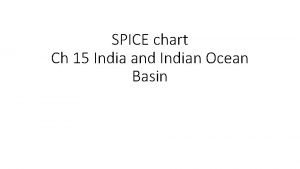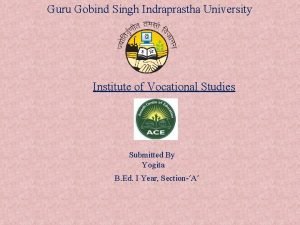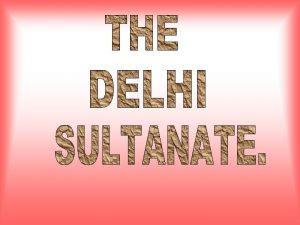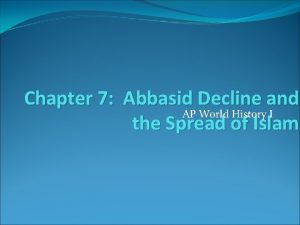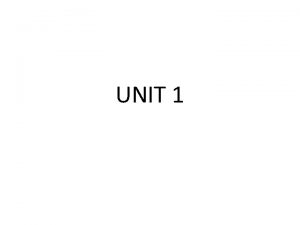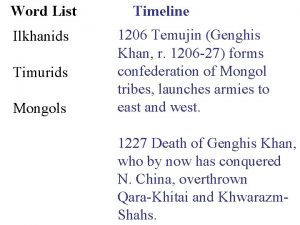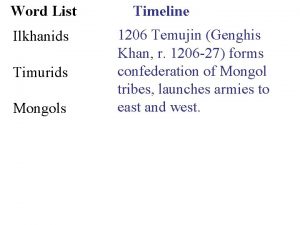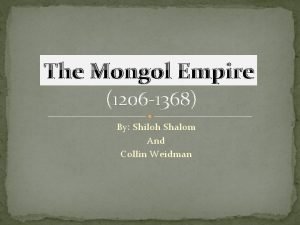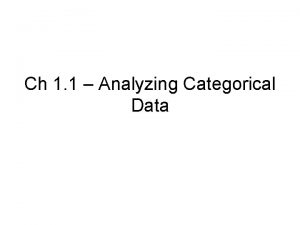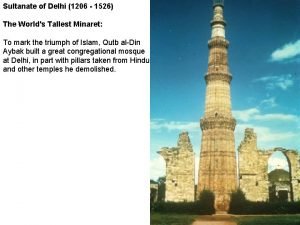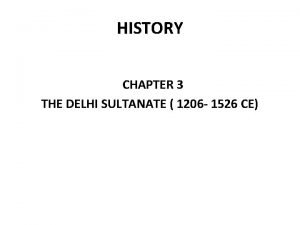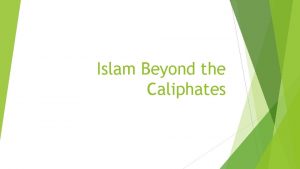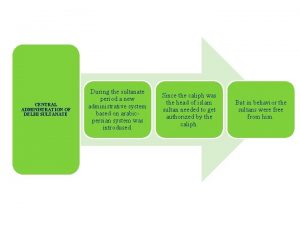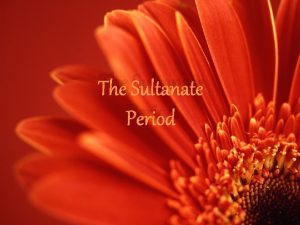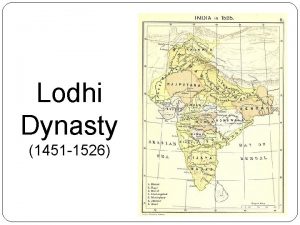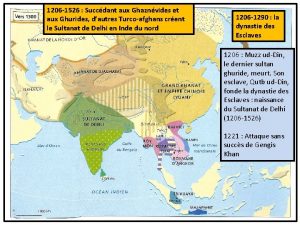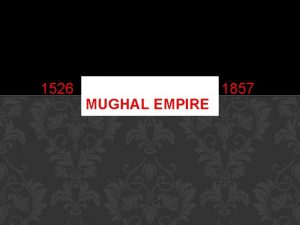Administration of the Sultanate of Delhi 1206 1526













- Slides: 13

Administration of the Sultanate of Delhi 1206 -1526

Layers of Administration § The administrative structure of the Delhi Sultanate can be divided into three layers: § Central, § Provincial, § Local

Central Administration § Sultan was the head of the state and fountainhead of all the administrative structure. § Assisted by a Wazir or the prime minister, who was the in-charge of Diwan-i Wizarat. Head of the bureaucracy. § Next to him was Mushrif-i Mumalik (the accountant general) and Mustaufi-i Mumalik (the auditor general).

Main Departments at the Centre § Diwan-i Risalat (Department for Religious Affairs) was placed under Sadr al-Sudur. § Diwan-i Qaza (Department for Justice) under Qazi al -Quzzat (the Chief Justice) § Diwan-i Mazalim (Department for Grievance Redress) under Amir-i Dad. § Diwan-i Arz (Military Department) was under Ariz-i Mumalik.

• Diwan-i Insha (Department for Royal Correspondence) was under Dabir-i Khas. • Diwan-i Barid (Information & Espionage/Intelligence Department) was under Barid-i Mumalik. • Diwan-i Khairat (Charity Department) was meant for poor relief. • Diwan-i Amir-i kohi (Department for Agriculture) under Amir-i kohi.

Other important officials at Center § Wakil-i Dar was the chief dignitary of the royal household. § Amir-i Hajib was the chief chamberlain and the master of ceremonies at the court. § Kotwal was the head of the Police Department. § Muhtasib inspected the public morals and market practices. § Amir-i Shikar was responsible for the royal hunt. § Amir-i Majlis was responsible for organizing private parties for the Sultan. § Naqibs or ushers proclaimed royal orders to the army and to the general public. § Jandars or the body-guards of the Sultan were responsible for the personal safety and security of the Sultan.

Provincial and Local Administration § The Sultanate of Delhi was divided into provinces. § The provincial governors performed the same duties or functions which the Sultan performed at the centre. § Some of the governors were called Muqtis while some were called Walis. The Walis were more powerful than the Muqtis.

• Provinces were sub-divided into shiqqs or sarkars (districts), which were placed under the charge of Shiqdars (district officers). • Next unit of administration was parganah (towns), where Chaudhari was the parganah officer. • At local level, in villages there were panchayats which controlled the local administration.

Fiscal Administration of the Sultanate §Diwan-i Riyasat was placed under Rais, who was responsible for regulating the market affairs and economy. §In the provinces, Sahib al-Diwan or Amil was responsible for collection of revenue.

The sources of revenue in the Sultanate of Delhi § Zakat (religious tax on the Muslims, which is 2. 5% of their annual savings) § Jizya (poll-tax levied on non-Muslims) § Import duties on merchandise § Ghanimah (spoils of war or booty) § Ushr (agricultural tax levied at the rate of 10% of the annual produce) § Kharaj (tribute from the tributary states conquered by the Sultan)

Recruitment Policies § The nobility, a coalition of the Turks and the Taziks or Tajiks. § The Turks generally occupied all the senior military positions. § The Tajik filled civil appointments. § Indian Muslims were generally excluded from high official positions. § The Khalji government was relatively more tolerant and inclusive towards Indians. § The Tughluq era was also marked by appointment of Indians on high state positions.

Governance Patterns in the Sultanate of Delhi § Different governance patterns in various regions. § At the centre, there was direct political control of the state. § In provincial capitals, garrison towns and important cities, there was relatively strong political control as compared to the rural areas. § There existed internally well-organized, selfadministering and more or less independent sub-communities in rural areas in those days.

Levels of Political Authority § Iqta a unit of administration. § It was under the direct control of the Sultan or the centre. § The iqtas were governed by the Muqtas, appointed by the Sultan. § (ii) Wilayats were province-like units of administration directly controlled by the centre. § The walis (like provincial governors, appointed by the Sultan) controlled their respective wilayats. § § (iii) Tributary States existed in Delhi Sultanate, such as in Deccan under Sultan ‘Ala al-Din Khalji, which were indirectly ruled by him. § complete autonomy but they used to pay annual tribute or khiraj to the centre. § § (iv) Aqlim It was ruled by semi-independent Muslim kings, who occasionally used to send khiraj (tribute) to the centre. §
 Delhi sultanate spice chart
Delhi sultanate spice chart Decline of the delhi sultanate
Decline of the delhi sultanate Introduction of alauddin khilji
Introduction of alauddin khilji Delhi sultanate ap world history
Delhi sultanate ap world history Conclusion of delhi sultanate
Conclusion of delhi sultanate Ferret mongols
Ferret mongols Reglamento 1206/01
Reglamento 1206/01 A word 1206
A word 1206 1206-1368
1206-1368 Westerlies
Westerlies Indochine
Indochine Msc circular 1206
Msc circular 1206 1761-1526
1761-1526 Yellowstone national park surveyed a random sample of 1526
Yellowstone national park surveyed a random sample of 1526
